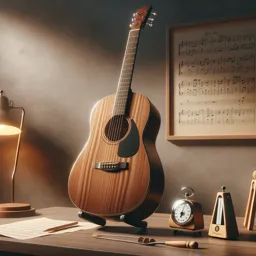Introduction
Learning to play the guitar is an exciting journey, but it can also be challenging, especially for beginners. Many new guitarists make common mistakes that can hinder their progress and enjoyment. Identifying and addressing these mistakes early on can lead to a more rewarding learning experience. This article explores some of the most frequent mistakes beginners make and provides tips on how to avoid them.
1. Incorrect Posture and Hand Position
Mistake: Beginners often adopt incorrect posture or hand positions, leading to discomfort and difficulty playing.
Solution:
- Posture: Sit or stand with your back straight. If sitting, rest the guitar on your right leg (for right-handed players) or left leg (for left-handed players). Use a footstool if necessary.
- Hand Position: Keep your thumb behind the neck of the guitar, not over it. Your fingers should arch over the strings, pressing them down with your fingertips.
2. Neglecting to Tune the Guitar
Mistake: Playing an out-of-tune guitar can make practice frustrating and hinder ear training.
Solution:
- Tune Regularly: Use a tuner to ensure your guitar is in tune before each practice session. With time, learn to tune by ear.
3. Rushing Through Chord Changes
Mistake: Beginners often rush chord changes, resulting in sloppy transitions and unclear chords.
Solution:
- Slow Down: Practice changing chords slowly and accurately. Focus on clean transitions before increasing speed.
- Use a Metronome: A metronome can help maintain a consistent tempo and improve timing.
4. Ignoring Rhythm and Timing
Mistake: Playing without regard for rhythm and timing can lead to uneven and erratic playing.
Solution:
- Practice with a Metronome: Use a metronome to develop a sense of timing and rhythm. Start slow and gradually increase the tempo.
- Count Out Loud: Counting the beats out loud can help internalize the rhythm.
5. Avoiding Music Theory
Mistake: Some beginners avoid learning music theory, thinking it’s too complicated or unnecessary.
Solution:
- Start Simple: Begin with basic concepts like understanding chord progressions, scales, and key signatures.
- Apply Theory to Practice: Relate theory to what you play. For example, learn the theory behind the chords and scales you practice.
6. Practicing Inconsistently
Mistake: Irregular practice schedules can slow progress and make it harder to develop muscle memory.
Solution:
- Set a Routine: Establish a regular practice schedule. Even 15-20 minutes daily can be more effective than longer, infrequent sessions.
- Stay Consistent: Consistency is key to improvement. Make practice a part of your daily routine.
7. Not Using a Metronome
Mistake: Beginners often overlook the importance of practicing with a metronome, leading to poor timing.
Solution:
- Practice with a Metronome: A metronome helps develop a sense of timing and ensures that you play at a consistent tempo.
- Start Slow: Begin with a slow tempo and gradually increase the speed as you become more comfortable.
8. Skipping Warm-Ups
Mistake: Jumping straight into playing without warming up can lead to tension and injury.
Solution:
- Warm-Up Exercises: Start with simple finger exercises and stretches to warm up your hands and fingers.
- Focus on Technique: Use warm-up time to focus on proper technique and finger placement.
9. Overlooking Ear Training
Mistake: Relying solely on visual cues and neglecting ear training can limit musical development.
Solution:
- Play by Ear: Practice playing simple melodies by ear. This can improve your ability to recognize and replicate sounds.
- Use Ear Training Apps: Utilize apps and online resources to develop your ear for pitch and harmony.
10. Being Too Hard on Yourself
Mistake: Expecting too much too soon and being overly critical can lead to frustration and discouragement.
Solution:
- Set Realistic Goals: Break down your learning into manageable steps and set achievable goals.
- Celebrate Progress: Acknowledge your improvements, no matter how small. Celebrate milestones and enjoy the journey.
Conclusion
Avoiding these common mistakes can help beginners develop good habits and make steady progress in their guitar playing. By focusing on correct posture, consistent practice, proper technique, and incorporating music theory and ear training, new guitarists can enjoy a more fulfilling and successful learning experience. Remember, patience and perseverance are key—every great guitarist started as a beginner.

























